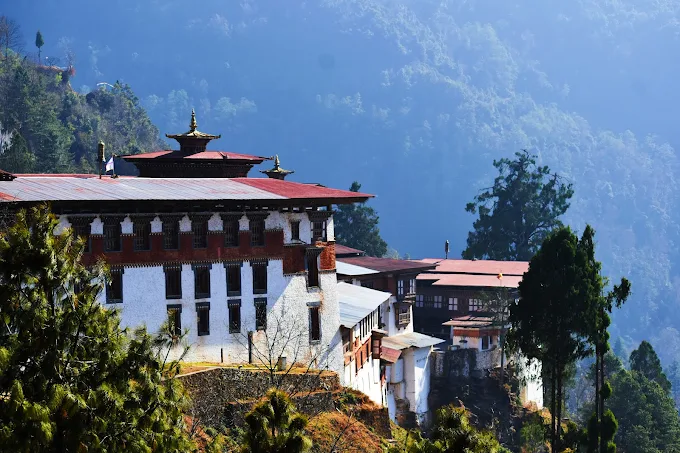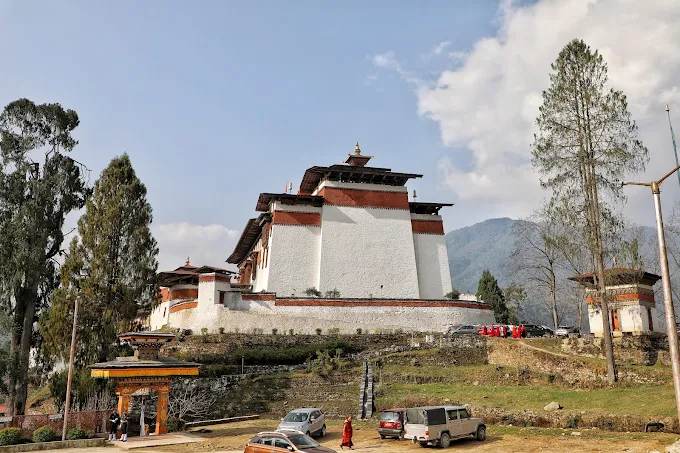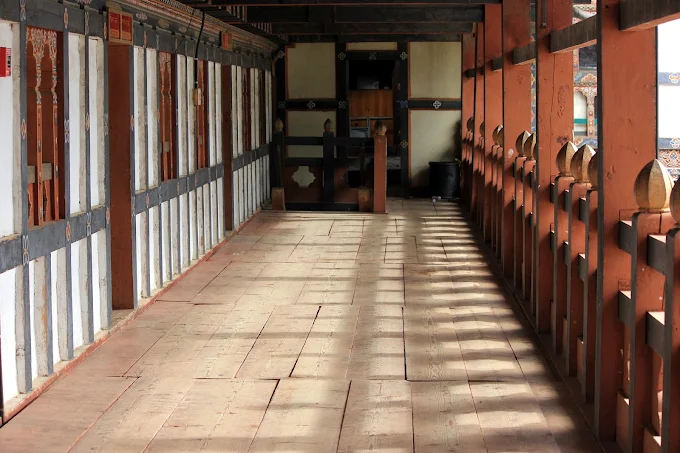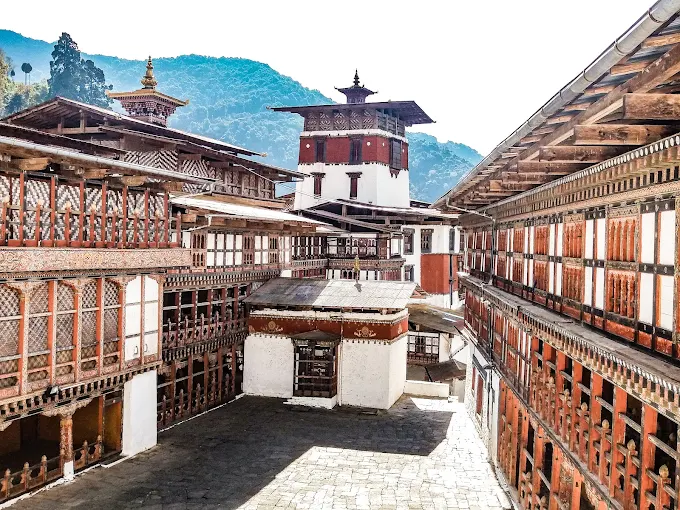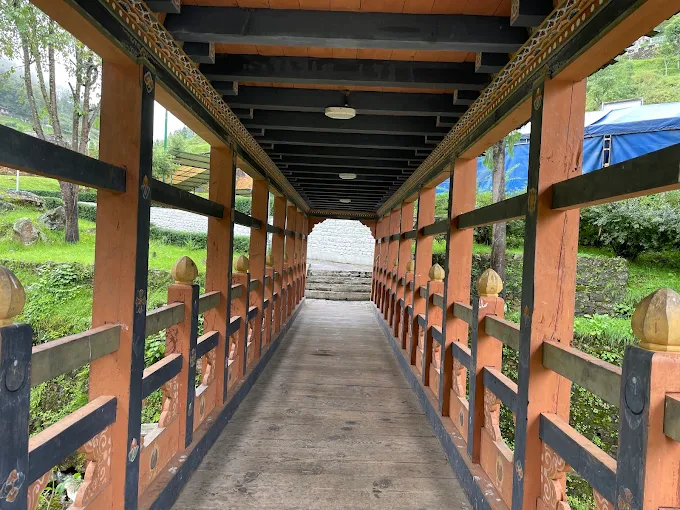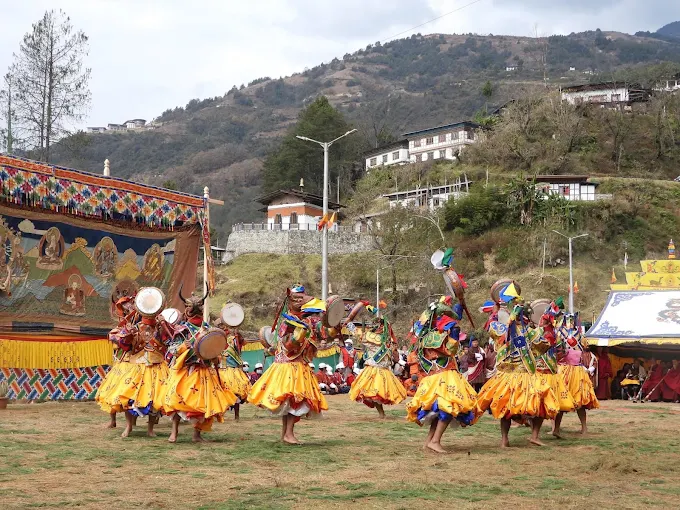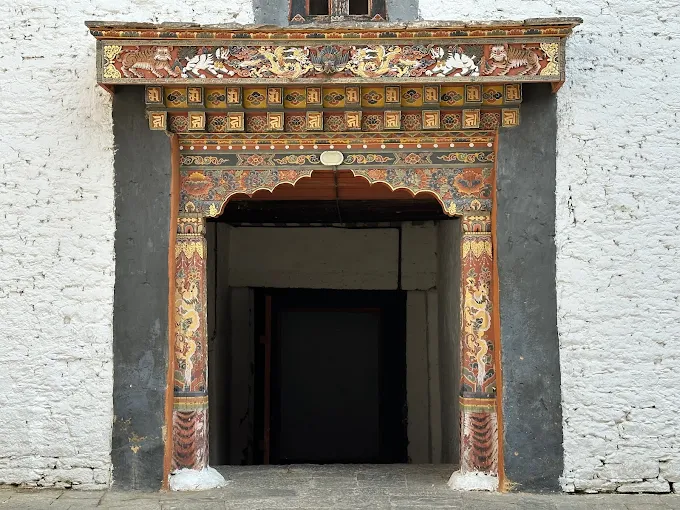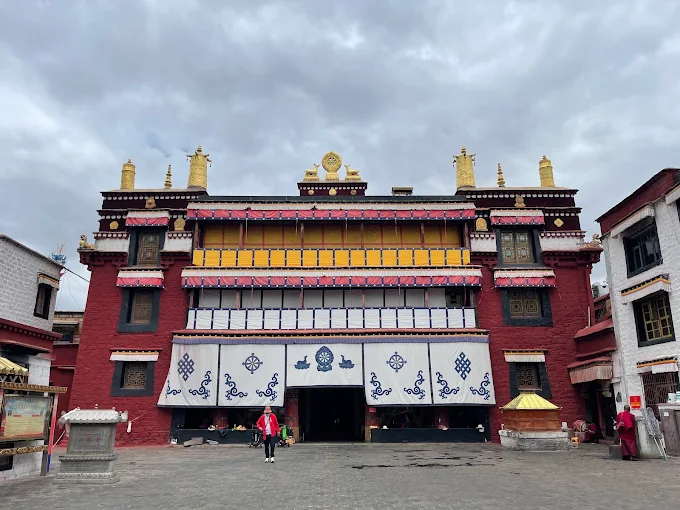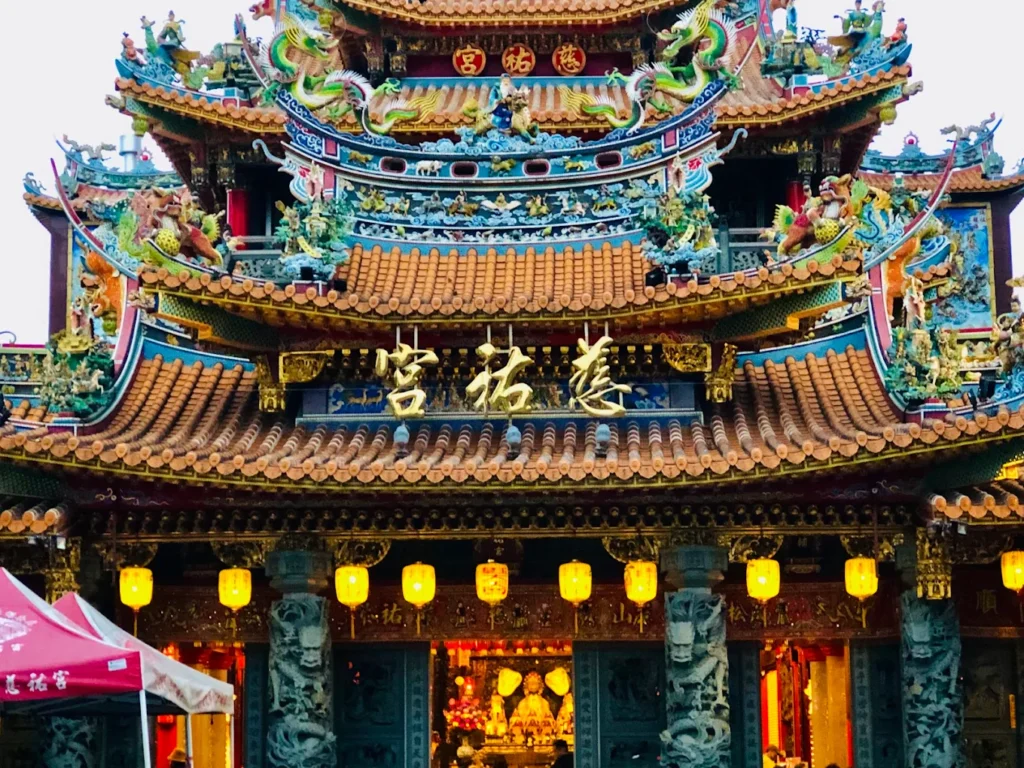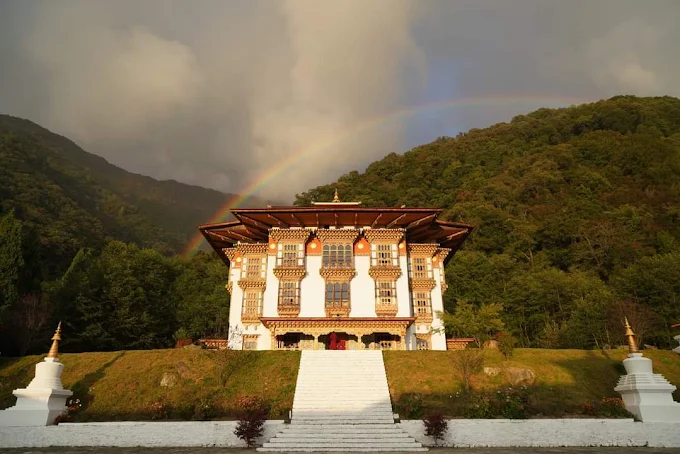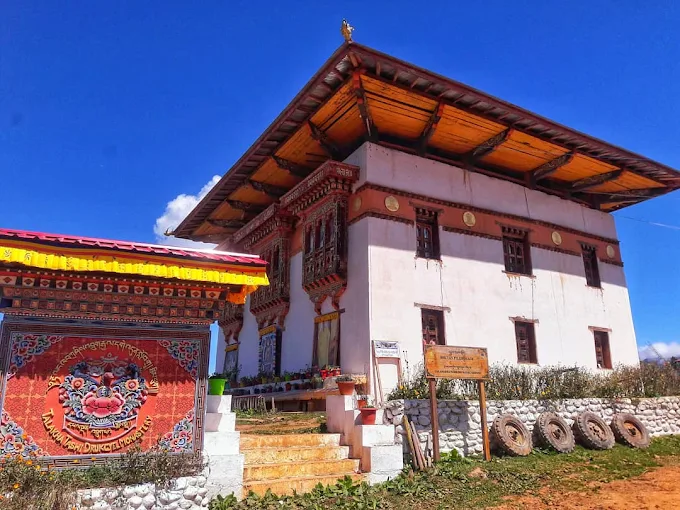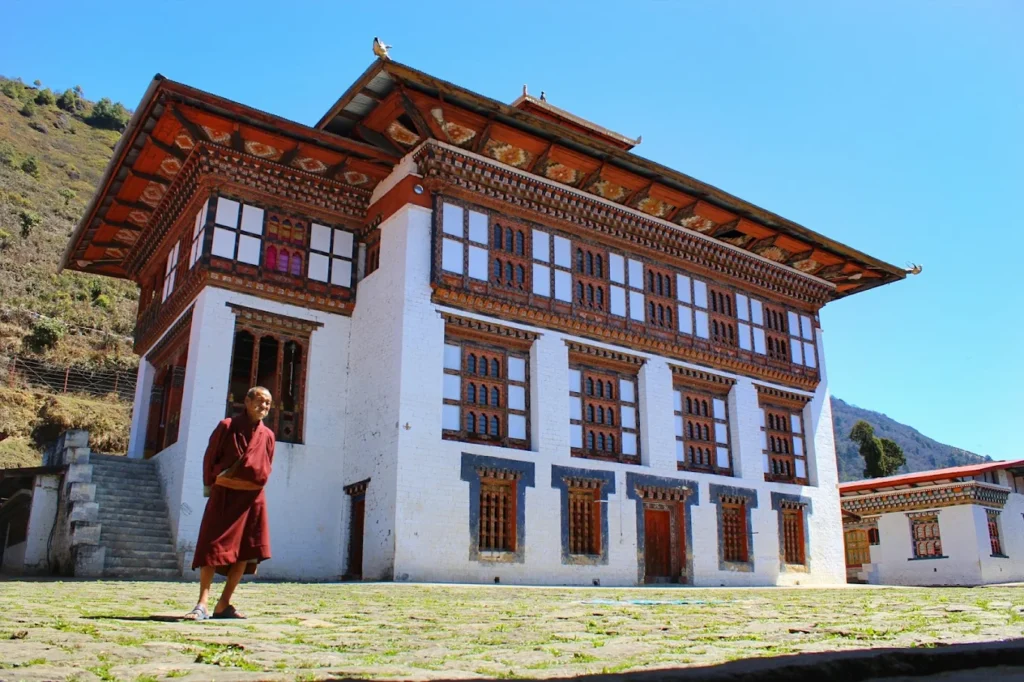Trongsa Dzong: The Watchful Fortress of Trongsa’s Drukpa Kagyu Heritage
Rising with imposing grandeur atop a spur overlooking the Mangde Chhu River, where the morning mist clings to the rugged slopes of Trongsa Valley, Trongsa Dzong stands as a sentinel of Bhutan’s spiritual and historical legacy, its stone walls aglow with dawn’s light. Within the sacred main temple (lhakhang), monks chant the Om Mani Padme Hum mantra, their voices reverberating around a statue of Zhabdrung Ngawang Namgyal, the unifier of Bhutan. Constructed in 1644 by Chogyal Minjur Tenpa under Zhabdrung’s guidance, this Drukpa Kagyu fortress served as the administrative center of Trongsa, its golden roofs piercing the sky. The air carries the scent of sandalwood incense, lit to honor the sacred relics of Pema Lingpa, while prayer flags flutter against the Himalayan breeze, blessing the valley below. From its strategic hilltop perch, Trongsa Dzongkhag unfolds in a sweeping panorama, connecting the dzong to Bhutan’s heart of governance and spirituality. This sacred haven invites travelers, seekers, and scholars to ascend its slopes and immerse themselves in the enduring strength of Drukpa Kagyu devotion.
Whispers of Governance: Overview and Significance
Introduction to Trongsa Dzong
Trongsa Dzong, majestically positioned on a spur above the Mangde Chhu River in Trongsa Dzongkhag, Bhutan, stands as a revered Drukpa Kagyu sanctuary, celebrated for its historical role as the administrative hub of Trongsa and its commanding hilltop presence. A steep climb or drive from Trongsa town reveals a spiritual fortress where the river’s flow and surrounding hills create an atmosphere of reverence. Known as Chhoekhor Rabtentse (Village of the Cuckoo’s Call), it embodies Bhutan’s spiritual heritage, blending meditation with governance. A cultural and sacred landmark, the dzong weaves history, authority, and Himalayan reverence into a timeless refuge.
Historical Journey
Trongsa Dzong was founded in 1644 by Chogyal Minjur Tenpa, the first Penlop of Trongsa, under the direction of Zhabdrung Ngawang Namgyal, who unified Bhutan and chose the site for its strategic advantage. Initially a small watchtower, it was expanded into a grand dzong by 1647, serving as the seat of the Trongsa Penlop, a position that later became a stepping stone to the Bhutanese throne. The dzong faced a significant fire in 1897, with restoration efforts led by the second King, Jigme Wangchuck, completed by 1900. Further expansions and maintenance have preserved its role as a spiritual and administrative center, reflecting Bhutanese resilience.
Cultural Significance
- Drukpa Kagyu Devotion: Rooted in the Drukpa Kagyu lineage, the dzong venerates Zhabdrung Ngawang Namgyal and Pema Lingpa, emphasizing meditation and spiritual leadership.
- Bhutanese Heritage: A spiritual and administrative anchor, it preserves rituals like mantra recitation and tsechu ceremonies, reflecting national identity.
- Governance Legacy: As the Trongsa Penlop’s seat, it shaped Bhutan’s political history.
- Regional Influence: Pilgrimages and festivals draw devotees from Trongsa and central Bhutan, fostering unity.
Unique Legacy
- Hilltop Fortification: Its strategic perch above the Mangde Chhu symbolizes protection, a verified architectural marvel.
- Sacred Relics: Houses the remains of Pema Lingpa and a sandalwood statue of Zhabdrung, central to Drukpa Kagyu.
- Historical Endurance: Survived fires and time, reflecting Bhutanese resilience.
- Cultural Symbol: Its governance role mirrors Bhutan’s spiritual and political fortitude.
Community and Global Impact
- Local Devotion: The dzong hosts festivals and monastic retreats, strengthening Trongsa’s Buddhist ties.
- Pilgrimage Hub: Thousands visit annually, drawn by its relics and scenic beauty.
- Global Appeal: International scholars and tourists seek its historical and spiritual significance.
- Cultural Dialogue: Shared rituals unite Bhutanese and global visitors, fostering understanding.
Modern Relevance
- Spiritual Retreat: Trongsa Dzong offers a haven for mindfulness in its historical role.
- Cultural Preservation: It safeguards Drukpa Kagyu practices, ensuring Bhutan’s heritage thrives.
- Historical Legacy: Its past as a political center inspires national pride.
Historical Anecdotes
- Zhabdrung’s Vision: His 1644 guidance shaped the dzong’s foundation.
- Penlop Tradition: The Trongsa Penlop’s rise to kingship marked a historic shift.
- Fire Resilience: The 1897 rebuild showcased community spirit.
Social Role
- Community Hub: Festivals and monastic gatherings unite Trongsa’s Buddhists.
- Educational Center: Monks train in Drukpa Kagyu practices, nurturing spiritual growth.
- Charitable Spirit: Communal feasts reflect Drukpa Kagyu compassion.
Artistic Influence
- Thangka Art: Murals of Zhabdrung inspire Bhutanese artists.
- Cultural Icon: The dzong’s hilltop view graces local imagery.
- Festival Art: Cham dance masks showcase Bhutanese craftsmanship.
Trongsa Dzong’s hilltop stronghold, where Chogyal Minjur Tenpa once fortified Bhutan’s unity, weaves a narrative of devotion and governance that defines the Drukpa Kagyu legacy. From its 1644 foundation to its role as a historical retreat, the dzong’s history resonates with the authority of the Mangde Valley, uniting monks and pilgrims. Its sacred halls and scenic courtyards set the stage for an architectural tapestry that mirrors its Himalayan soul. As we delve into its physical and spiritual features, Trongsa Dzong’s design reveals how its watchful beauty nurtures profound faith and leadership.
Crafted by the Spur: Architectural and Spiritual Features
Iconic Design
Trongsa Dzong’s architecture blends Drukpa Kagyu fortitude with its strategic hilltop setting, creating a sanctuary that harmonizes with Trongsa’s rugged terrain. Towering whitewashed stone walls and wooden cantilevered roofs, adorned with prayer flags, rise from the 2,200-meter elevation, reflecting Buddhist grandeur. The multi-dochey layout, centered on the utse (central tower), balances administrative and spiritual functions, with courtyards fostering community. Its perch above the Mangde Chhu River, overlooking Trongsa Dzongkhag, amplifies its sacred resonance, tying the dzong to Bhutan’s Himalayan ethos.
Key Structures
- Main Lhakhang: The spiritual core, housing Pema Lingpa’s relics, rebuilt post-1897.
- Utse (Central Tower): A multi-story structure with a golden spire, expanded in the 17th century.
- Kuenrey (Assembly Hall): A hall with murals of Guru Rinpoche’s life, restored in 1900.
- Goenkhang: A temple dedicated to protective deities, with restricted access.
- Chorten Courtyard: Stone stupas honor lamas, surrounded by prayer wheels.
- Watchtower: A northern outpost, part of the original 1644 structure.
Worshipped Statues
- Zhabdrung Ngawang Namgyal: A sandalwood statue, symbolizing unity, radiates spiritual authority.
- Pema Lingpa: A gilt statue, representing treasure revelation, stands prominently.
- Chenrezig (Avalokitesvara): A white stone statue, symbolizing compassion, flanks the altar.
- Spiritual Role: Monks offer butter lamps to Zhabdrung, seeking guidance and protection.
Materials and Techniques
- Construction: Compacted earth, stones, and timber for roofs, joined with Bhutanese methods.
- Artistry: Detailed wood carvings and thangka murals, crafted by Trongsa artisans, reflect Drukpa Kagyu style.
- Cultural Essence: The design merges fortress practicality with monastic serenity, unique to early dzongs.
Signature Elements
- Hilltop Spur: The strategic perch above the Mangde Chhu symbolizes defense, a verified marvel.
- Utse Spire: The golden top, added in the 17th century, signifies spiritual elevation.
- Prayer Flags: Fluttering flags carry blessings across the valley.
Lesser-Known Features
- Ancient Thangkas: Faded murals in the Kuenrey depict Guru Rinpoche’s deeds.
- Hidden Shrine: A naga altar in the goenkhang, linked to local beliefs.
- Old Prayer Wheel: A weathered mani wheel, in use since the 17th century.
Preservation Efforts
- Restoration (1900): Rebuilt after the 1897 fire under Jigme Wangchuck’s guidance.
- Challenges: Hill erosion and weather test stonework, requiring maintenance.
- Modern Additions: Solar lights enhance evening safety.
Environmental Integration
- Spur Harmony: The dzong’s design respects Trongsa’s forest ecosystem.
- Eco-Practices: Monks maintain grounds and protect flora.
- Wildlife Haven: Birds nest nearby, enhancing serenity.
Artisan Narratives
- Mural Painters: Trongsa artists restored thangkas, preserving art.
- Wood Carvers: Local craftsmen rebuilt the utse, blending tradition.
- Stone Masons: Community members reinforced walls post-fire.
Symbolic Details
- Prayer Flags: Five colors balance elements, spreading dharma.
- Chortens: Represent the Buddha’s mind, guiding pilgrims.
- Thangkas: Depict enlightenment’s path, inspiring faith.
Landscape Integration
- Hilltop Perch: Enhances strategic and spiritual focus.
- Mangde Chhu Views: The river’s flow mirrors inner calm.
- Pine Slopes: Provide solitude and spiritual resonance.
Trongsa Dzong’s stone lhakhangs and sacred courtyards, guarding the Mangde Valley, are more than architectural marvels; they are sanctuaries for the Drukpa Kagyu practices that define its spiritual soul. The statue of Zhabdrung, illuminated by butter lamps, anchors rituals that connect monks to Bhutan’s spiritual lineage. These hallowed spaces, alive with chants and governance, invite visitors to engage with the dzong’s living traditions. As we explore its rituals, Trongsa Dzong’s role as a meditative and historical fortress comes to life, guiding devotees toward leadership and enlightenment.
Rites of the Watchtower: Rituals and Practices
Daily Sacred Rites
- Morning Chanting: Monks recite the Om Mani Padme Hum mantra at dawn, fostering compassion.
- Meditation Sessions: Silent meditation, held twice daily, centers on Mahamudra practices.
- Butter Lamp Offerings: Devotees light lamps before Zhabdrung, praying for guidance.
Unique Practices
- Relic Veneration: Monks honor Pema Lingpa’s remains in the main lhakhang.
- Protective Puja: Rituals appease local spirits, seeking hill stability.
- Signature Ritual: Offering khata scarves at Zhabdrung’s statue, tied to its governance legacy.
Festival Traditions
- Trongsa Tshechu (9th lunar month): A three-day festival with cham dances and thangka displays.
- Lhabab Duchen: Ceremonies honor the Buddha’s descent, with chorten circuits.
- Losar (Bhutanese New Year): Monks perform purification rites, blessing visitors.
- Statue Veneration: Zhabdrung’s statue is adorned with silk during festivals.
Visitor Engagement
- Accessible Rituals: Visitors can join chants or offer khatas, guided by monks.
- Offerings: Butter lamps and prayer flags, available at the dzong, invite participation.
- Drukpa Etiquette: Bow before statues and maintain silence during ceremonies.
Spiritual Community Roles
- Monastics: Over 200 monks, led by the Trongsa Dratshang, conduct rituals.
- Lamas: Senior monks guide relic veneration and pujas.
- Lay Devotees: Trongsa villagers maintain grounds and offer supplies.
Interfaith Connections
- Syncretic Practices: Some blend Drukpa rites with Bon offerings, honoring naga spirits.
- Outreach: Festivals welcome diverse faiths, fostering unity.
- Education: Monks share Drukpa Kagyu teachings with visitors.
Ritual Symbolism
- Butter Lamps: Represent wisdom dispelling ignorance.
- Khata Offerings: Symbolize purity and devotion.
- Cham Dances: Enact spiritual victories over adversity.
Seasonal Variations
- Autumn Rites: Vibrant with harvest, ideal for Trongsa Tshechu.
- Winter Ceremonies: Cold enhances monastic focus.
- Monsoon Chants: Rain amplifies mantra resonance.
Monastic Life
- Daily Routine: Monks rise at 4:00 AM for chants, meditation, and governance duties.
- Community Service: Monks guide pilgrims and maintain lhakhangs.
- Training Hub: Monks learn Drukpa Kagyu philosophy, supporting Trongsa’s faith.
Trongsa Dzong’s rituals, from the Om Mani Padme Hum mantra to relic veneration, breathe life into its hilltop sanctuary, connecting devotees to the Drukpa Kagyu lineage. The dzong’s spiritual practices, rooted in Bhutan’s governance and faith, invite visitors to engage with its historical heart, whether through chants or silent reflection. For travelers, these rites offer a glimpse into Trongsa’s sacred traditions, accessible within its fortified grounds. As we turn to visitor information, Trongsa Dzong’s hilltop setting guides practical planning, ensuring a meaningful journey to this watchful retreat.
Journey to the Spur: Visitor Information
Navigating to Trongsa Dzong
- Location: Trongsa Dzongkhag, 2,200 meters, accessible via a trail from Trongsa town across the suspension bridge.
- Landmarks: Near the Mangde Chhu River and Trongsa town center, with Dzongkha and English signs.
- Routes: Walk across the suspension bridge from Trongsa town (15–20 minutes).
Address of Trongsa Dzong
- Dzongkha: Trongsa Dzong, Trongsa Dzongkhag, Bhutan.
- English: Trongsa Dzong, Trongsa District, Bhutan.
Visiting Hours and Etiquette
- Hours: Open daily, 9:00 AM–5:00 PM, with midday breaks for monastic activities.
- Etiquette: Dress modestly, remove shoes before lhakhangs, and avoid disturbing rituals.
- Drukpa Custom: Offer butter lamps with both hands and bow to statues.
Transport Options
- By Foot: Walk from Trongsa town across the suspension bridge (15–20 minutes, easy difficulty).
- By Vehicle: Drive to the bridge approach, then walk.
- By Bicycle: A scenic ride suits active visitors to the bridge.
Accessibility and Safety
- Mobility: Steep steps may challenge those with mobility issues; no ramps available.
- Safety: Stable paths with railings; carry water for the climb.
- Tips: Wear comfortable shoes and bring layers for weather changes.
Amenities and Surroundings
- Facilities: Restrooms near the entrance; no shops on-site.
- Nearby: Kuenga Rabten Palace and Ta Dzong, within 1–2 km, offer cultural experiences.
- Dining: Picnic areas encourage packed meals, with options in Trongsa town.
Immersive Visitor Tips
- Best Timing: Morning visits offer quiet chants and cooler weather.
- Sensory Moments: Inhale sandalwood-scented air and hear river flows.
- Statue Connection: Offer butter lamps to Zhabdrung and reflect briefly.
- Festival Planning: Attend Trongsa Tshechu for cham dances.
Nearby Cultural Experiences
- Kuenga Rabten Palace: A royal residence, 1 km away, linked to the second King.
- Ta Dzong: A watchtower museum, 2 km away, offers historical insight.
- Trongsa Viewpoint: A scenic spot, 1.5 km away, features valley panoramas.
Photography Tips
- Best Angles: Capture the utse at sunrise for golden light.
- Respectful Shots: Avoid photographing monks during rituals without permission.
- Scenic Views: The Mangde Valley offers stunning vistas.
- Equipment: A smartphone or lightweight camera suffices.
The ascent to Trongsa Dzong, guided by Trongsa’s hilltop trails, is a pilgrimage that blends spiritual discovery with historical exploration, inviting visitors to engage with its Drukpa Kagyu traditions. The dzong’s lhakhangs and courtyards, vibrant with chants and relics, offer a window into Bhutan’s sacred heart, where authority feels tangible. Beyond its hilltop beauty, Trongsa Dzong’s deeper cultural and spiritual significance enriches the experience, revealing the essence of Himalayan Buddhism. As we explore these insights, the dzong’s role as a beacon of faith and governance comes into sharper focus, deepening our connection to its sacred legacy.
Insights of the Watchtower: Cultural and Spiritual Reflections
Drukpa Kagyu Philosophy
Trongsa Dzong embodies Drukpa Kagyu’s core: compassion and wisdom through meditation and governance. Zhabdrung Ngawang Namgyal and Pema Lingpa inspire devotees to seek unity, reflected in chants and relic veneration. Mahamudra teachings emphasize direct realization, guiding monks toward enlightenment.
Environmental Spirituality
The dzong’s hilltop perch ties it to Himalayan reverence for nature. The Mangde Chhu’s flow and surrounding hills foster meditative calm, with offerings honoring naga spirits. The landscape invites reflection on harmony with the natural world.
Artistic Symbolism
Thangka murals depict Zhabdrung’s leadership, symbolizing spiritual triumph. Chortens represent the Buddha’s mind, while prayer flags balance elements. These elements weave Drukpa Kagyu ideals into the dzong’s aesthetic.
Community Resilience
Founded by Chogyal Minjur’s followers, Trongsa Dzong reflects Bhutanese perseverance through fires and time. Its 1900 rebuild showcases collective faith, sustained by volunteer efforts, uniting Trongsa’s Buddhists.
Environmental Stewardship
The dzong’s slopes foster Buddhist environmental ethics. Monks protect trails and forest, ensuring balance. Visitors are urged to honor the spur’s sanctity.
Meditative Practices
Drukpa Kagyu meditation, including Mahamudra, cultivates awareness. The lhakhang offers spaces for governance retreats, guided by lamas, amplifying inner peace.
Cultural Narratives
- Zhabdrung’s Legacy: His 1644 foundation inspires devotion.
- Penlop Tales: The Trongsa Penlop’s rise links past and present.
- Festival Lore: Trongsa Tshechu dances carry ancient traditions.
Historical Context
- Unification Era: Zhabdrung’s work shaped Bhutan’s Buddhist identity.
- Penlop Governance: The Trongsa Penlop’s role defined political history.
- Disaster Recovery: Restorations reflect cultural continuity.
Reflecting on the Journey
Trongsa Dzong, cradled on Trongsa’s sacred spur, is a sanctuary where authority meets wisdom. Its lhakhangs and courtyards, alive with Zhabdrung’s legacy, embody Bhutan’s Drukpa Kagyu soul, inviting all to seek enlightenment. The dzong’s trails, worn by centuries of pilgrims, tell a story of resilience and devotion, rooted in Himalayan faith. Whether meditating before Pema Lingpa’s relics, witnessing Trongsa Tshechu, or tracing Bhutan’s governance heritage, visitors find a space to reflect and connect. As you depart, the Mangde Chhu’s murmur and prayer flags’ flutter linger, a reminder that strength is always within reach.
